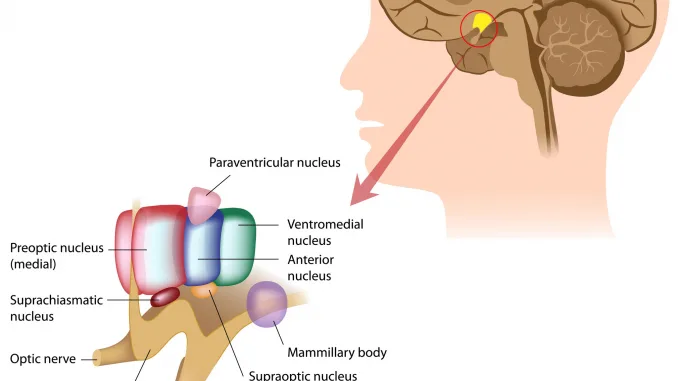
The hypothalamus is a small, crucial region located at the base of the brain, just above the brainstem. Despite its size, the hypothalamus plays a central role in regulating various physiological processes, including endocrine function. It serves as a vital link between the nervous system and the endocrine system, ensuring the body’s internal balance, or homeostasis, is maintained.
Anatomy of the Hypothalamus
The hypothalamus is a complex structure composed of several nuclei, each with specific functions. It is anatomically and functionally connected to the pituitary gland, forming a critical axis known as the hypothalamic-pituitary axis (HPA).
Hormones Produced by the Hypothalamus
The hypothalamus produces and releases several key hormones, often referred to as hypothalamic releasing hormones or inhibiting hormones. These hormones travel through a network of blood vessels to the anterior pituitary gland, where they influence the release of pituitary hormones. The major hormones released by the hypothalamus include:
- Gonadotropin-Releasing Hormone (GnRH):
- Function: Stimulates the release of gonadotropins (luteinizing hormone and follicle-stimulating hormone) from the anterior pituitary, which, in turn, regulate the function of the gonads (testes in males, ovaries in females).
- Corticotropin-Releasing Hormone (CRH):
- Function: Stimulates the release of adrenocorticotropic hormone (ACTH) from the anterior pituitary, which then stimulates the adrenal glands to produce and release cortisol.
- Thyrotropin-Releasing Hormone (TRH):
- Function: Promotes the release of thyroid-stimulating hormone (TSH) from the anterior pituitary, regulating the thyroid gland’s secretion of thyroid hormones (T3 and T4).
- Somatostatin:
- Function: Inhibits the release of growth hormone (GH) from the anterior pituitary, controlling overall growth and metabolism.
- Dopamine:
- Function: Inhibits the release of prolactin from the anterior pituitary, helping regulate lactation.
Role in Stress Response
The hypothalamus also plays a crucial role in the body’s response to stress. When faced with a stressor, the hypothalamus releases CRH, initiating the stress response cascade. This results in the release of cortisol from the adrenal glands, which helps the body cope with stress by mobilizing energy and suppressing non-essential functions.
Integration of Nervous and Endocrine Systems:
The hypothalamus acts as an interface between the nervous system and the endocrine system, receiving signals from various parts of the brain and the body. Neurons in the hypothalamus can directly influence hormone release, responding to changes in internal and external environments.
The hypothalamus is also involved in the regulation of body temperature, hunger, thirst, and circadian rhythms. It integrates sensory information, such as temperature and nutrient levels, to adjust physiological functions and maintain internal balance.
Hypothalamic-Pituitary Axis (HPA)
The HPA is a crucial regulatory system that involves the hypothalamus, pituitary gland, and target endocrine glands. It controls the release of hormones that regulate various physiological processes, including metabolism, growth, and reproduction.
- Release of Hypothalamic Hormones:
- The hypothalamus releases its hormones in response to internal and external stimuli.
- Stimulation of Pituitary Gland:
- Hypothalamic hormones travel through the bloodstream to the anterior pituitary, stimulating or inhibiting the release of pituitary hormones.
- Release of Pituitary Hormones:
- Pituitary hormones then target specific endocrine glands, stimulating them to release their hormones.
- Target Organ Response:
- The hormones released by the endocrine glands exert their effects on target organs, influencing various physiological processes.
Clinical Implications
Disruptions in the function of the hypothalamus can lead to various endocrine disorders. For example, tumors in the hypothalamus can affect hormone production and release, causing imbalances in the endocrine system. Dysfunction in the HPA axis is also associated with conditions like Cushing’s syndrome and Addison’s disease.
Conclusion
In summary, the hypothalamus is a critical brain region that serves as the master regulator of the endocrine system. Through the production and release of key hormones, it orchestrates the body’s response to stress, regulates growth and metabolism, and ensures the maintenance of internal balance. The intricate interplay between the hypothalamus, pituitary gland, and target endocrine organs highlights the complexity of endocrine regulation and its significance in overall physiological well-being.

Leave a Reply